Make content the centre of your earned, owned and paid strategy
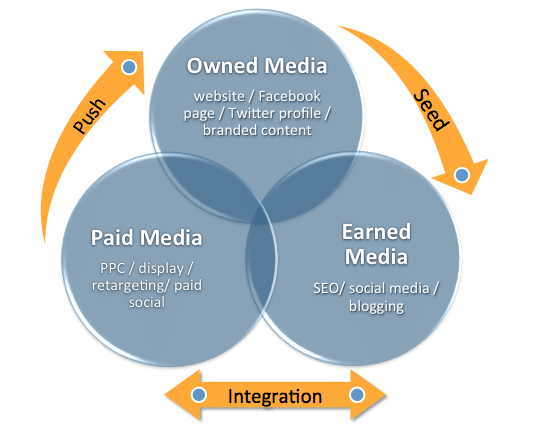
Despite content frequently being looked at as the answer, that doesn’t mean that it’s always the first solution for your business.
I’m often asked the question “why great content matters”, and that can be very difficult to answer, mainly because despite running a large number of content campaigns for clients, it’s never a question we would start with first.
Content Strategy
Going back a step, it has to be about strategy. You really need to think about your business goals and marketing objectives.
This could be anything from:
- Raising brand awareness
- Improving your SEO and online authority
- Building your social audience
- Increasing direct sales or leads
- etc…
» Read more about: Make content the centre of your earned, owned and paid strategy »
Why and how to create an editorial calendar using Trello
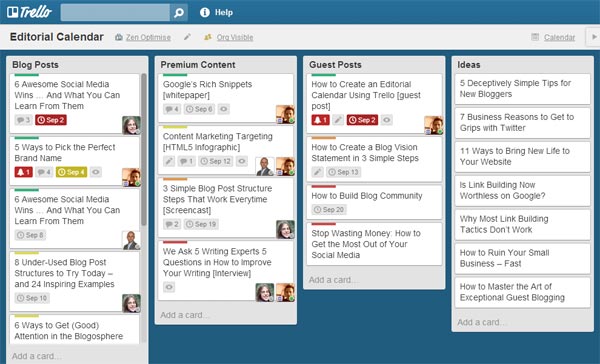
If you’ve tried out Trello already, you’re probably a fanboy like me. It’s an easy-to-use project management and calibration tool with a visualizer finish that makes you want to use it for nearly everything.
Did I say it was free? And they keep adding lots of cool new features. Like the new Calendar, which is an optional ‘Power-Up’ and something a few content marketers (me included) had been dreaming for.
» Read more about: Why and how to create an editorial calendar using Trello »
31 Tips to boost your digital PR outreach relationships

It’s important to connect your brand with appropriate bloggers and other influencers. Why? Because these digital influencers are an accessible touchpoint between you and your target market, websites and blogs are a great way to present products or services to the online community.
For in-house marketers, I’ve put together a few learnings and tips which I think will help you make the most of your digital PR potential, in the realm of bloggers.
What Brands Forget About Bloggers
Brands tend to think bloggers operate like other traditional marketing avenues, don’t make this mistake. Don’t forget these three things, at the risk of bloggers disliking you:
1. Bloggers spend a lot of time maintaining and updating their blog!
» Read more about: 31 Tips to boost your digital PR outreach relationships »
Ultimate Google manual penguin penalty link removal guide

Where do you start with a post penguin backlink clean up with a new client who spent most of last year removing links they built with their previous agency; and have submitted more than 8 “rejected” reconsideration requests in a year from a manual penalty?
A lot of posts and talks recently have discussed this, from the start of the campaign to the execution, but how would you begin and start a failed one?
Here’s my approach to establishing – ALL the URLs of your existing backlinks, and which links have been disavowed already.
This blog post is split into 4 sections:
- Part 1: Establishing The Poor Links
- Part 2: Finding Existing Backlink Domains
- Part 3: Establishing The Location of URL in a Domain
- Part 4: Understand What’s Been Disavowed?
» Read more about: Ultimate Google manual penguin penalty link removal guide »
27 Creative commons & royalty free websites for images
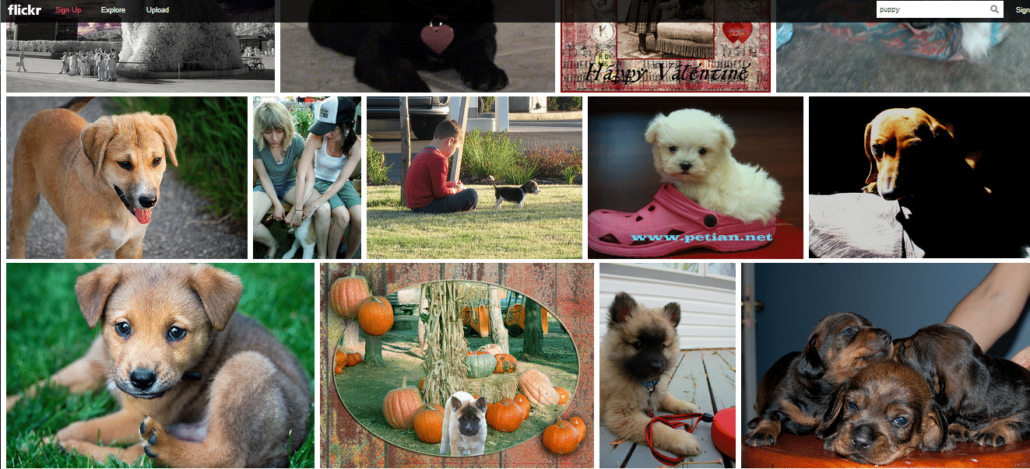
I’ve reviewed a number of websites offering up free images for commercial use in businesses. This means the site has to:
- Supply the images without requiring any money
- Clearly state that an image falls within Creative Commons (CC) or is royalty free
For more on those terms, refer to the bottom of this review. Some sites supply exclusively creative commons or royalty free images, while other sites offered a mix of images which were free for commercial use with those that were not. It’s always important to understand the restriction on an image before using it, so please do double check images.
Why is it important to use images in your content ?
» Read more about: 27 Creative commons & royalty free websites for images »
187 key takeaways from the content marketing show
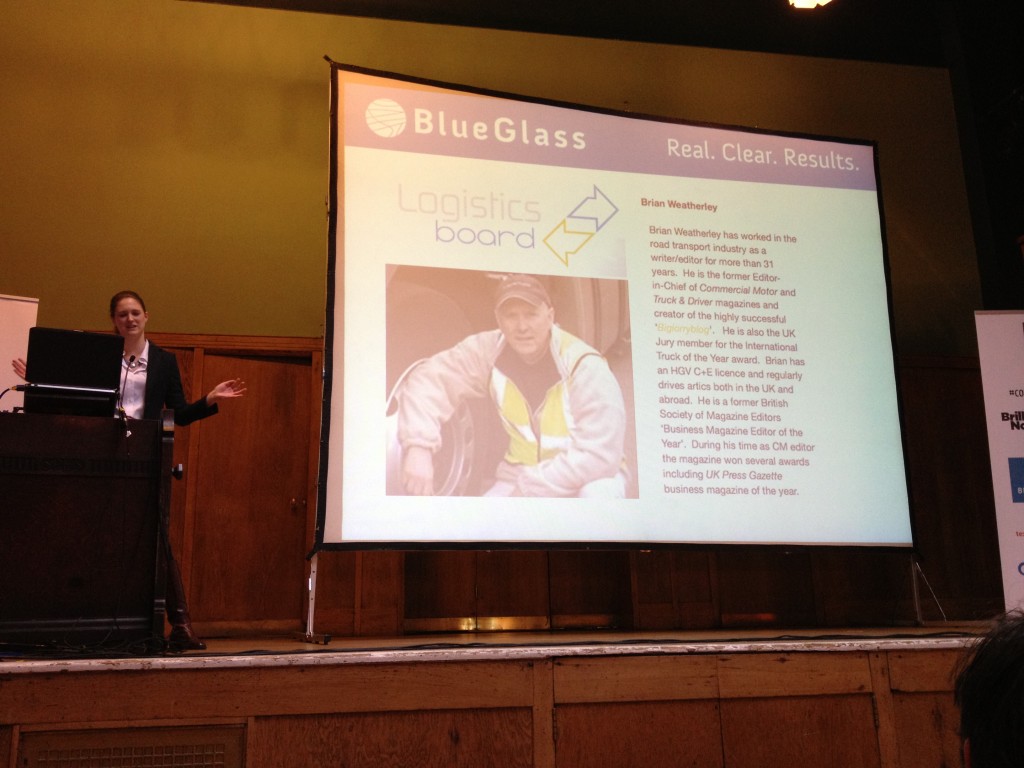
With more than 1000 SEOs, content marketers and in-house digital marketers in attendance the content marketing show on Friday the 31st of May was a sell-out. It brought together some of the top people within the industry to share their experiences and knowledge of content marketing.
The Sir Alex Ferguson’s way of Building the Best (Content) Team
Danny Denhard, VoucherCodes.co.uk
@dannydenhard
httpss://plus.google.com/112080127184383819662/posts
1. The team is the most important part when you’re picking content.
2. It is all about picking and having the right qualities.
3. You need a good goalkeeper in your team that is safe, has attention to detail, has great agility and protects the project.
4. You need a centre back in your team that communicates and leads the team from the front.
5. You need a Midfield workhorse in your team to do the ugly thing, to work for the team and get the best results out of you and your team.
6. You need an attacking midfield, the creative part of the team, who creates a system and communicates with people and drive the team forward in their own style.
7. You need at least one striker for every project, the PR and social media people. These will go and get you the results that you need.
8. If you don’t have a natural born leader in your team you’re going to struggle to get the right results.
9. Know when to make substitutions in order to keep it fresh and to get the best out of your people.
10. You need a substitution bench with reliable people.
11. Squad rotation helps to keep it fresh.
12. Make the project last until the final whistle –
» Read more about: 187 key takeaways from the content marketing show »
13 steps to defensible link building in a post-penguin world
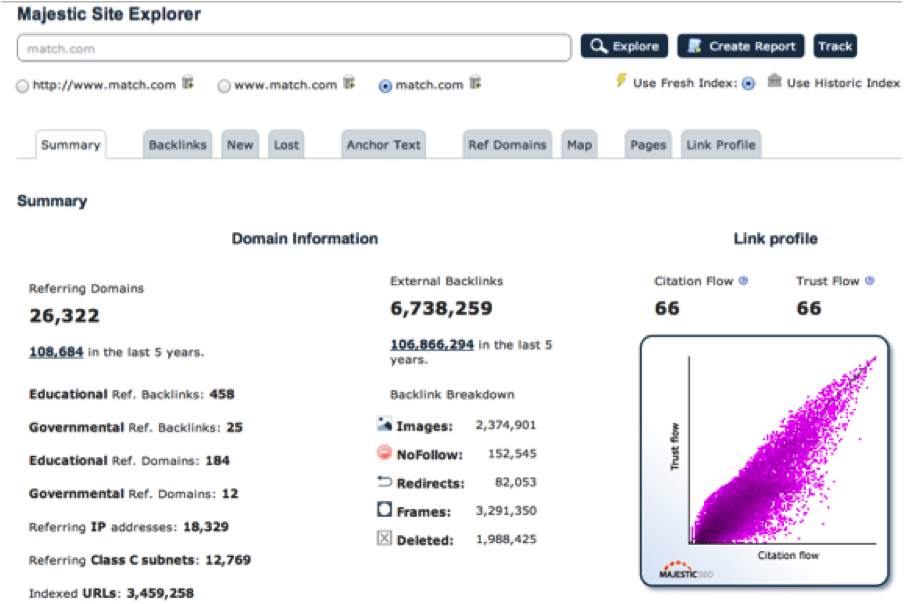
Are Panda and Penguin Related?
Looking back at Google’s algorithm updates over the last 12 months, I think we’re seeing a very similar trend:
- Panda = penalising websites with thin or weak content
- Penguin = penalising sites which have links from thin or weak content
When you think about Penguin and Panda updates in this way — in combination with the huge range of brand and social signals that Google are getting much better at reading and bringing into their algorithm — it becomes clear that human engagement and activity is starting to have a much greater impact on search results.
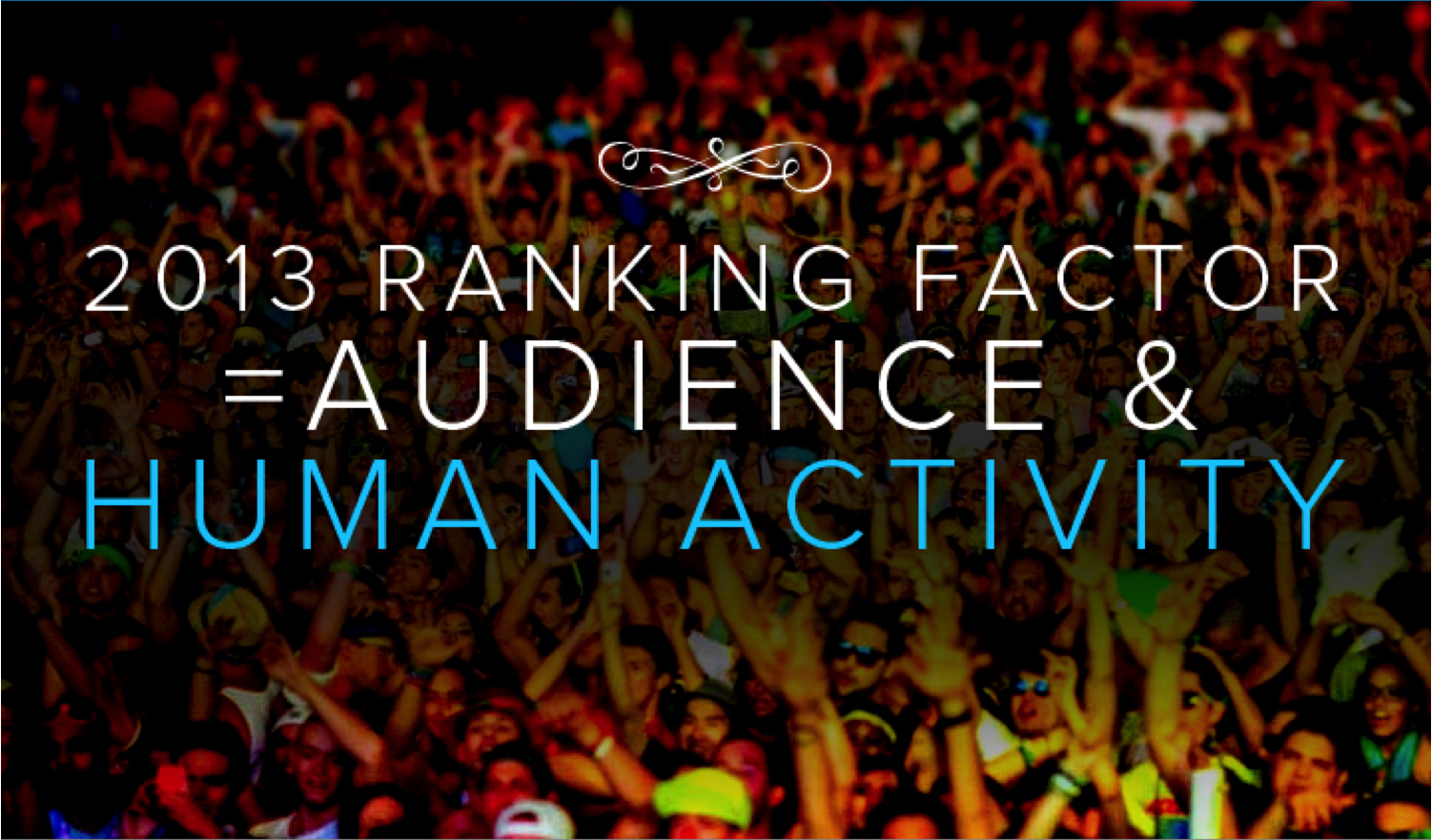
For example, here is an advert I saw in the London underground recently:
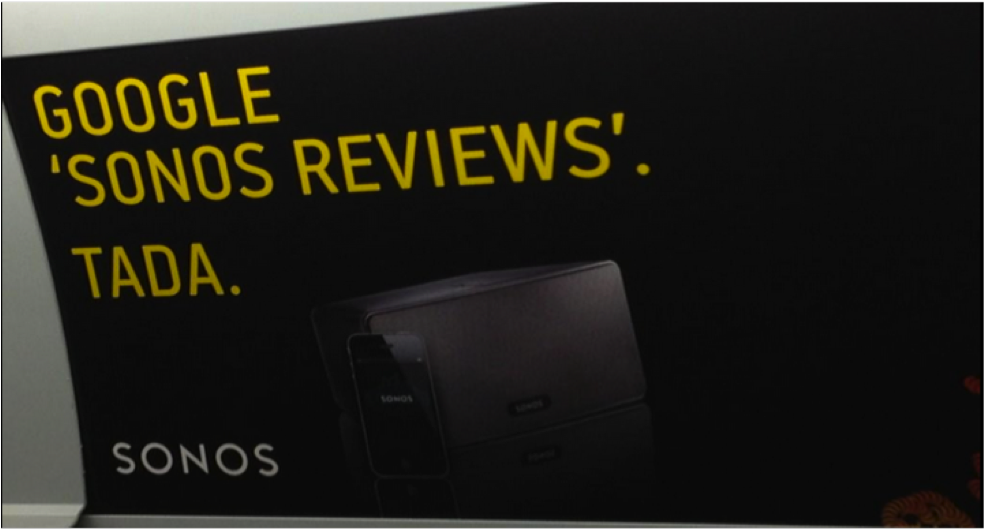
In my opinion, this type of advertising is genius. Firstly, it’s getting people to find out for themselves about the product from existing customers using third-party endorsements for honest reviews and showing that they are putting their money where their mouth is.
And secondly, Sonos are sending Google one the best messages you can: people are “talking” about their brand. We all know Google loves brands and they’re getting much better at reading the signs. So whether it’s branded anchor text or brand queries, Google knows there’s a popular brand behind this traffic increase, and maybe that brand deserves a bit more attention in the search engine result pages (SERPs) as a result.
That to me is the biggest shift — it’s now much more about building high quality links as a by-product of great content. Look at page authority in many ways, more than you would domain. If you have an active audience there, it’s relevant to readers or users;
» Read more about: 13 steps to defensible link building in a post-penguin world »
90 content marketing takeaways from BlueGlassX
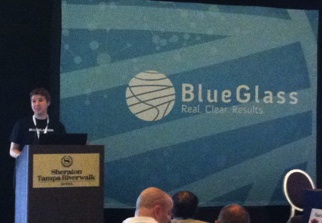
I spent last week in Tampa at the BlueGlassX conference. Upon returning from BlueGlass LA earlier this year, I said it was the best conference I’d ever been to, so I knew what to expect this time. BlueGlass LA was not only a great learning experience, but also was a pivotal point for me in deciding to join BlueGlass.
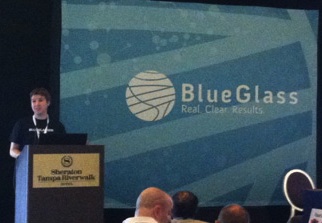 It was great to see things from the other side by presenting at the event, and now being a part of BlueGlass. I really appreciate all of the hard work and planning that goes on behind the scenes.
It was great to see things from the other side by presenting at the event, and now being a part of BlueGlass. I really appreciate all of the hard work and planning that goes on behind the scenes.
I learned a lot during the event. There were some truly great actionable takeaways. Although there are already great recapposts, I wanted to share some of the most useful tips and soundbites I found tweetable during the event. Here are my 90 takeaway tips from BlueGlassX in the form of tweets:

 Strategy
Strategy
- There’s no longer a debate whether or not content works. Google has made it the only way to go. @GregBoser
- Chase quality not money. Quality, method, and patience pay off. @GregBoser
- I ask potential clients more questions than they ask me – it’s an equal interview @GregBoser
- @lauralippay: I love hearing @GregBoser talk about agency structure and processes and especially *thinking ahead.*
- Radio ads that tell people to ‘google you’ are genius. Not only do you show up #1, but you give Google signals that matter. @GregBoser
- Brand queries associate your business with your industry/keywords with Google. @GregBoser
- 85% of @copyblogger‘s sales process is done through content marketing. It’s the invisible sales process.
- Main problem with SEO industry is people just look two weeks ahead!
» Read more about: 90 content marketing takeaways from BlueGlassX »
How to run a content audit to improve your SEO performance

When people start content marketing initiatives, they often have lots of new, exciting ideas and brainstorms about how they can generate lots of social attention, influence the influencers, and attract high-quality links.
However, it can be very easy to get carried away with all of these new ideas and concepts and forget that the best content for your brand, might already exist….
Content Auditing
The first step for us, in any content marketing project, is to perform a content audit.
This allows us to:
- understand what content your users like to see (traffic, links, interaction, social metrics etc.).
- analyse which content can be a) repurposed, b) better promoted or c) removed.
- find opportunities for new content ideas.
- make improvements to lift the overall content performance ratio of your site.
I remember finding Greg Boser’s post on SERP profiling extremely valuable last year, so I’m going to take you through the process we would use for content auditing. This uses Quaturo as an example. We have a very new site, which helps to keep things simple for now, and hopefully it’s a useful way to show how we would approach content auditing.
» Read more about: How to run a content audit to improve your SEO performance »
How to leverage RSS feeds for finding outreach opportunities
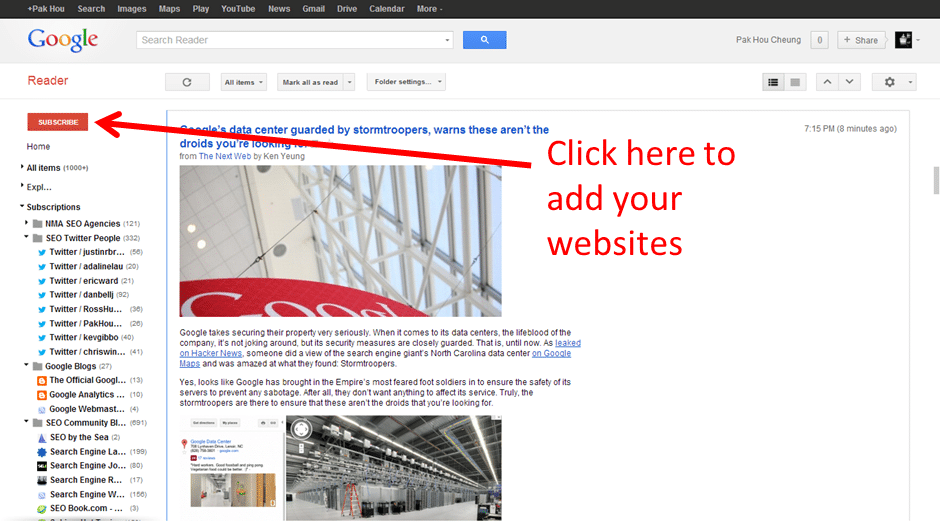
Have you ever thought about using Google Reader as more than just a place to store all your favourite blogs and instead leveraging it to:
- Improve your conversion rates for guest posting
- Develop better blogger outreach
- Save yourself time by having all your essential outreach resources in one location
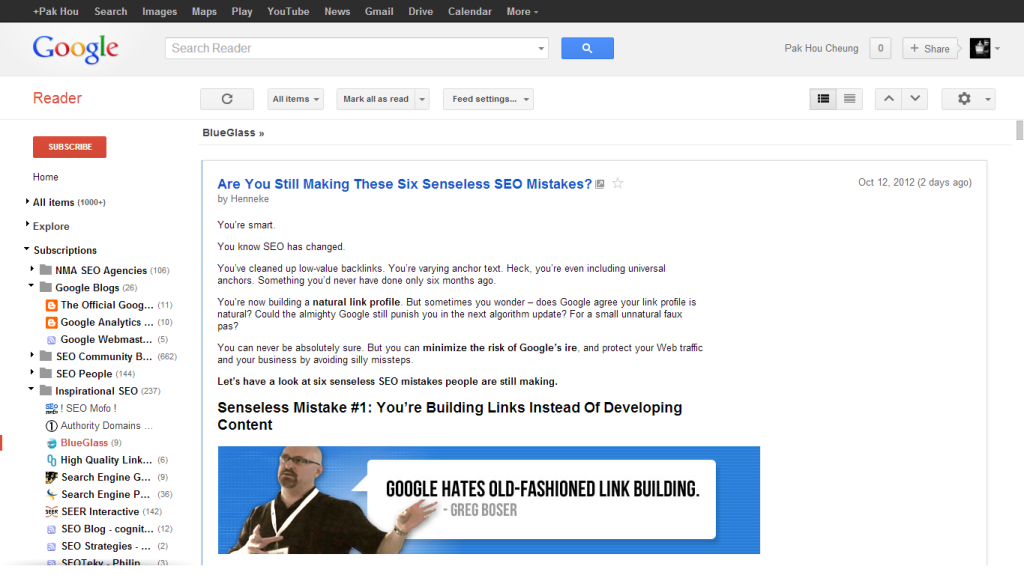
» Read more about: How to leverage RSS feeds for finding outreach opportunities »




